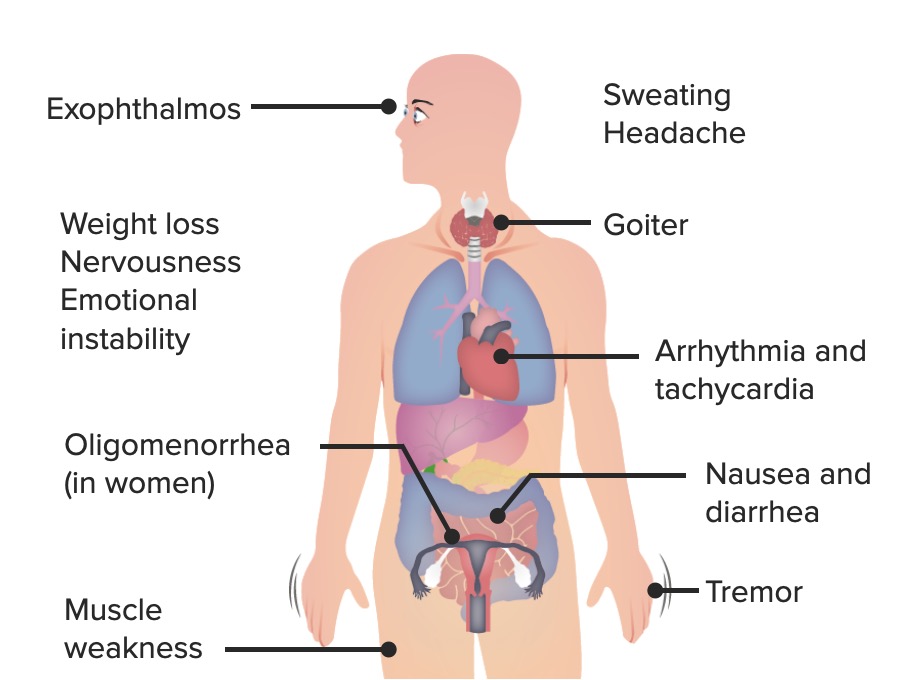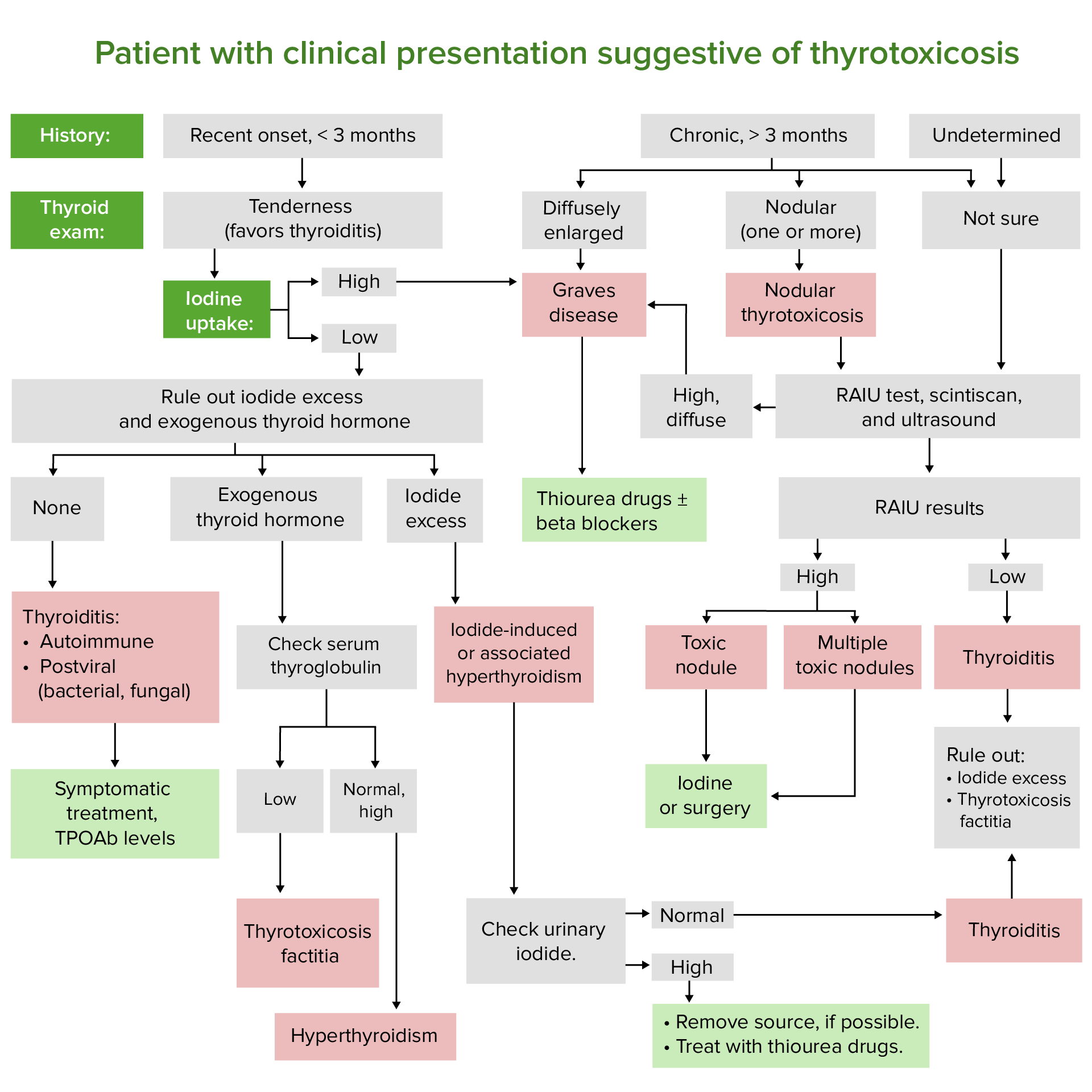Playlist
Show Playlist
Hide Playlist
Euthyroid Hypothyroxinemia – Euthyroid Conditions
-
Slides EuthyroidConditionsLaboratoryInvestigations EndocrinePathology.pdf
-
Reference List Pathology.pdf
-
Download Lecture Overview
00:01 If the previous discussion was euthyroid hyperthyroxinemia, this discussion now brings us to euthyroid hypothyroxinemia. 00:13 Euthyroid hypothyroxinemia due to, well, if the previous discussion was increased thyroid binding globulin, here you’re going to have decreased binding protein. 00:25 So, you’ll have binding protein abnormalities. 00:28 Let’s talk about those drugs. 00:31 There are a bunch of drugs here that you want to know that will cause euthyroid hypothyroxinemia. 00:39 Drugs that displace T4 from the binding site. 00:43 So if you now displace your T4 from your TBG, what faction are you increasing here transiently? The free. 00:54 Who is communicating with the hypothalamo-pituitary-thyroid axis? Is it the free or the bound? It’s the free. 01:02 As far as you’re concerned to get any of your questions correct, it is the free T4 that is going to dictate how much thyroid functioning that you’re having in the body. 01:16 Is that clear? In physiology, you’ve already talked about T4 and you have certain experts that’ll say, “Oh, no, no, no. 01:26 It’s T3 that’s going to be responsible for feedback mechanism.” Both individuals are correct, as far as you’re concerned as a clinician. 01:36 That T4, the free, is going to then regulate the feedback mechanism for your hypothalamus-pituitary and such. 01:45 So, here, if you were displacing your T4 from your TBG, due to the drugs such as salicylates, or NSAIDs then you’re removing the T4 from the bound. 01:59 The free T4 that is found to be excess is going to slide down the axis. 02:04 You’re in the state of euthyroid, but the total is decreased. 02:09 Why? Because these drugs removed or displaced the T4 from your TBG. 02:18 One important cause of euthyroid or one set of causes of euthyroid hypothyroxinemia. 02:25 Let’s talk about TBG deficiency. 02:28 It could be hereditary. 02:30 In the previous discussion there was euthyroid hyperthyroxinemia, also hereditary, but that’d be TBG excess. 02:39 That was XR-dominant. 02:41 Here we have XR-recessive, if you can remember. 02:46 Hormonal excess. 02:47 Which hormone is going to then shut down or slow down release of TBG from the liver? If in hyperthyroxinemia, your oestrogen in pregnancy that I’ve walked you through in great detail increase TBG and in this case we have the androgens that are going to slow down the release of TBG in the liver. 03:09 We have not only androgens – we have glucocorticoids and growth hormone. 03:14 Interesting enough, these would be more or less your stress hormones. 03:19 Acromegaly – excess growth hormone. 03:22 Glucocorticoids – stress hormone. 03:24 Welcome to cortisol, quote-unquote. 03:26 Androgen is the opposite of oestrogen in terms of its effects on your patient. 03:35 Hormonal excess causing decreased TBG. 03:38 Nephrotic syndrome – here we have loss of protein. 03:43 And meds - these include asparaginase, danazol and niacin, that may result in TBG deficiency. 03:51 Drugs are something that you want to keep in mind. 03:55 Our next section here, I’m going to give you more drugs that are heavily tested, clinically used, that cause euthyroid hypothyroxinemia that you want to be quite aware of. 04:08 Why have I not listed these in this illustration? Because the mechanisms, as we shall see, will be a little bit different. 04:16 Now, anticonvulsants (phenytoin, carbamazepine), heparin – extremely interesting. 04:23 We know a lot about heparin, a lot. 04:26 Heparin, in this case, let’s say that you have a patient who has DVT, symptoms of DVT. 04:34 And you then give heparin in a hospital setting. 04:39 How is it that heparin causes euthyroid hypothyroxinemia? It’s not that it displaces the T4 from your TBG, like we saw in the earlier discussion with NSAIDs, with salicylates. 04:52 It’s the fact that it increases lipoprotein lipase. 04:58 When you increase your lipoprotein lipase, brings you back to biochemistry, you’re then going to break up some of that lipid, aren’t you, such as chylomicrons and so forth. 05:10 And when you do so, you’re going to release free fatty acids. 05:14 That free fatty acids will then inhibit the T4 bonding resulting in euthyroid hypothyroxinemia. 05:21 Fascinating! Know it well. 05:26 The illustration earlier, I walked you through normal binding of T4 and then I walked you through increased TBG and how that increases total. 05:41 So, what’s happening here? All of the ideologies that I walked you through, in terms of drugs or maybe it’s hereditary and so on and so forth, maybe nephrotic syndrome, you’re going to be losing TBG. 05:53 So, there’s TBG deficiency. 05:57 If there’s TBG deficiency, then what happens to total? It decreases. 06:02 If your total decreases, then please understand that you’re in a state of hypothyroxinemia. 06:08 But, why are you euthyroid? Because the feedback mechanism is still intact. 06:13 Once again, you’re focusing upon now what is this that we’re seeing. 06:19 The resin, in how much of this resin is going to take up that T3. 06:25 You’ll notice here that with decreased bound, you could have excess T3 bound to resin. 06:34 Hence, the big thick black line. 06:38 Now, the way that you want to interpret this entire section is what I’m going to show you next with a summary table and once you’ve gone through the summary table, you should have these images in your head of euthyroid hypothyroxinemia versus euthyroid hyperthyroxinemia and the amount of TBG that’s available to bind to T4. 07:04 Let us now take a look.
About the Lecture
The lecture Euthyroid Hypothyroxinemia – Euthyroid Conditions by Carlo Raj, MD is from the course Thyroid Gland Disorders.
Included Quiz Questions
What is a cause of thyroid-binding globulin (TBG) deficiency that may lead to euthyroid hypothyroxinemia?
- Nephrotic syndrome
- Salicylate use
- NSAID use
- Horner syndrome
- Charcot-Marie-Tooth disorder
Which of the following is not a cause of thyroid-binding globulin (TBG) deficiency?
- An X-linked dominant condition
- Androgen excess
- Nephrotic syndrome
- Danazol
- Niacin
Which medication inhibits T4 binding by increasing the amount of free fatty acids?
- Heparin
- Phenytoin
- Carbamazepine
- Mefenamic acid
- L-asparaginase
What would be the result of the feedback mechanism seen in euthyroid hypothyroxinemia?
- A low level of total thyroid hormone is caused by an increase in free thyroid hormone as a result of decreased TBG.
- Increased total thyroid hormone due to decreased TBG.
- No change to thyroid hormone release but an increase in conversion from T4 to T3.
- No change in thyroid hormone.
- An increase in free thyroid hormone leads to a decrease in total thyroid hormone.
Customer reviews
3,0 of 5 stars
| 5 Stars |
|
0 |
| 4 Stars |
|
0 |
| 3 Stars |
|
1 |
| 2 Stars |
|
0 |
| 1 Star |
|
0 |
Dr. Raj speed in speaking distracts me and make following him very difficult. Very poor usage of schematics and a lot of text in his presentations.





